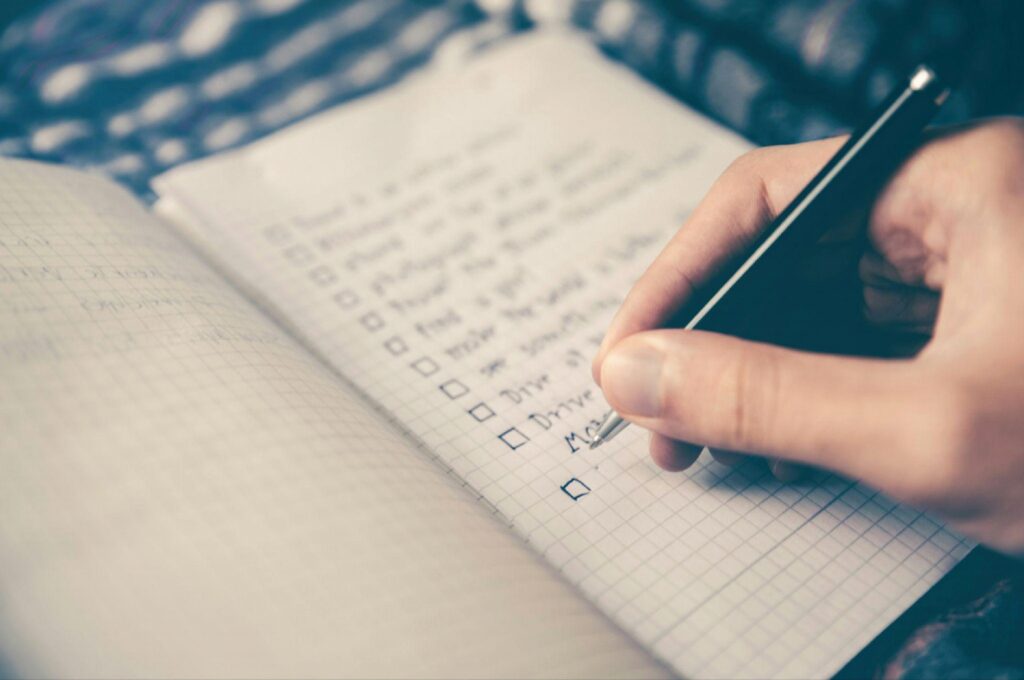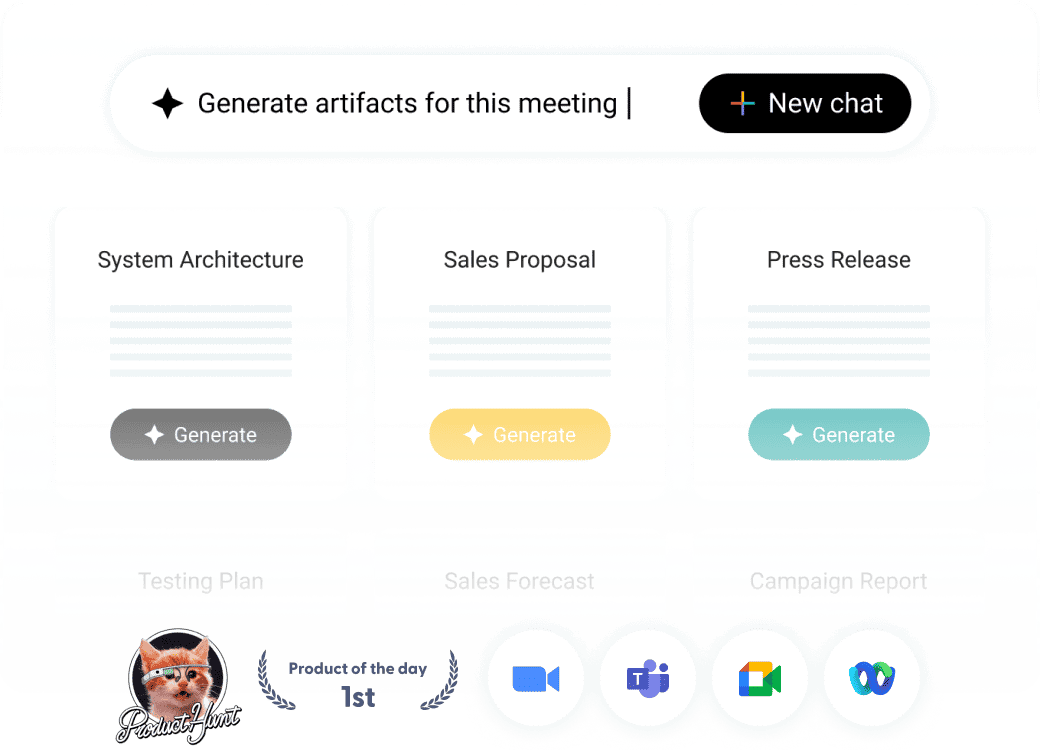Table of Contents
ToggleRecently updated on September 20th, 2024
The art of taking notes is an essential skill for students, professionals, lifelong learners, and virtually anyone who deals with a large amount of information. Once a matter of pen and notebook, note-taking methods have diversified, offering more tools and techniques than ever before. Whether you need to quickly jot down major concepts when attending lectures or record a Google Meet call, finding the right approach to note-taking is key to successful understanding and retention.
In today’s guide, we’ll explore various note-taking methods, from traditional pen-and-paper methods to advanced digital tools that do most of the work for you, allowing you to focus on what really matters. Along the way, we’ll outline the strengths and weaknesses of each technique, providing clear examples of usage and practical tips on how to take notes with a particular method. But first things first.
Traditional Note-Taking Methods
Let’s begin with the most traditional note taking formats. They typically involve jotting down important information manually with pen and paper or tapping it on a laptop using simple note apps. These methods are probably the first thing that comes to mind for anyone who needs to make notes. To do so, you just need to open the notebook or text editor and begin making notes. These methods are quite flexible and fast in implementation, so in one way or another, they have been tried by almost everyone.
Handwritten Notes
Many people still prefer these tactile and straightforward methods despite the rise of digital tools. Handwritten notes are the easiest way to improve memory and understanding, and they are accessible to everyone under most circumstances. In many settings where typing can be disruptive, in environments with strict digital security, or just during fieldwork, handwritten notes remain the most reliable way to memorize things quickly and easily.

Pros of Handwritten Notes:
- Available for anybody everywhere under any circumstances;
- Avoid interruptions from notifications and apps (compared to digital note taking styles);
- Flexible in visualization, allowing the writer to quickly jot down sketches and diagrams;
- Lightweight and portable;
- Requires no power, Internet, or battery life;
- Ready to use without any setup or logins;
Cons of Handwritten Notes:
- Physical notes take up space and can be easily lost;
- Difficult to search for specific information quickly;
- Harder to share with others compared to digital notes;
- No backups;
- Editing challenges;
- Handwriting may be hard to read later;
- Limited formatting options, lacking multimedia capabilities, such as videos and links;
- Time-consuming;
- Extended writing can cause hand fatigue;
- Using paper may be less eco-friendly than digital options.
Typing Notes on a Laptop
Another method from our traditional examples of note taking list is typing on your laptop. It allows for easy organization and editing, making it suitable for both students learning and professionals working. With various software options available, this method offers features such as spell-checking and cloud storage. However, it also comes with some drawbacks compared to other ways to take notes.

Pros of Typing on a Laptop
- Typing is often faster than handwriting;
- Digital notes are easier to organize and categorize;
- Simple to edit and update notes without rewriting;
- Quickly find specific information with search functions;
- Easily shareable;
- Digital storage conserves physical space;
- Using cloud-based documents enable easy access to notes from any device with Internet connectivity;
Cons of Typing Notes on a Laptop
- Potential for distractions from other apps and notifications;
- Battery dependency;
- Less tactile than manual writing;
- Requires carrying a laptop;
- Reliant on the Internet for most cloud-based features;
- Prolonged screen use can cause eye strain;
- Less suited for freeform expressions like diagrams and sketches.
Digital Note-Taking Methods
When we talk about the significant evolution of note taking styles, we refer mostly to digital methods, like voice-to-text apps or special tablets with styluses, which appeared in the last few years. New opportunities allow for hands-free note-taking by converting speech into written text or adding a modern twist on traditional handwriting, providing tactile satisfaction of writing with the flexibility of digital storage and editing.
Using Tablets and Styluses
Quite an interesting digital alternative to traditional methods is using tablets and styluses. It combines the tactile feel of handwriting with the benefits of digital technology. This method is great for easy editing, organizing, and sharing of notes it offers. At the same time, it supports multimedia integration, allowing you to insert images, diagrams, and links directly into your notes. Tablets and styluses can be ideal for users who want the flexibility of digital tools while retaining the natural flow of writing by hand.

Combining the Best of Both Worlds
- Tactile feedback;
- Easy editing of grammar mistakes;
- Multimedia integration;
- Searchable;
- This method has backups;
- Lightweight and easiest to carry than a laptop;
- Supports access from multiple devices;
- Highly customizable in terms of different colors, styles, and templates.
Cons of Using Tablets and Styluses
- Battery dependency;
- Potential for distractions from other apps;
- Initial investment can be high (considering they are not a very versatile devices);
- Requires time to get used to the device and specific software;
- Fragile;
- Less variation in tactile feedback compared to paper;
- Heavily relies on software.
Voice-to-Text Note-Taking
Voice-to-text note-taking is based on the conversation of spoken words into written text using speech recognition technology. This hands-free method is arguably the fastest way to capture notes, making it an ideal choice for multitasking or situations where typing or writing isn’t practical. Paired with a good device, voice-to-text apps are useful for quickly transcribing lectures, meetings, or brainstorming sessions. They offer a convenient way to capture thoughts on the go.

Pros of Voice-to-Text Note-Taking
- Hands-free;
- Rapid;
- Enables you to take notes while doing other tasks;
- Accessible for individuals with physical disabilities;
- Efficient in terms of effort;
- Easy to use;
- Notes are easily searchable and organizable;
- Often integrates with other applications and tools;
- Has backups.
Cons of Voice-to-Text Note-Taking
- May struggle with accents, dialects, or background noise;
- Risk of sensitive information being captured by the device;
- Not suitable for noisy or public settings, nearly incompatible with Google Meet rules and Zoom Etiquette;
- Often requires editing for accuracy and punctuation;
- Requires a reliable device with a battery and software;
- Difficult to structure notes on the fly;
- Not effective for capturing diagrams or equations at all;
- Requires familiarity with voice commands.
Structured Note-Taking Techniques
Now, when we’re finished with the question about how to take notes, let’s move on to how to take notes effectively. For this exact purpose, there are several structured note taking systems that provide efficient ways to organize and capture information. The methods we will discuss in the following section help you arrange notes in a clear and logical manner, enhancing both understanding and retention. So, let’s take a closer look at them, one by one.
Outline Method
The Outline method is one of the most straightforward systematic note-taking examples. This technique organizes notes in a hierarchical structure, using headings and subheadings to arrange information logically. This method helps you understand the relationship between main topics and details, making it easier to review and understand complex materials. Using this technique, you can quickly identify key points and supporting details, which makes it ideal for lectures and readings where information is presented in a structured format.
How the Outline Method Works
To use this method, start by writing the main topic at the top of the page. Pay attention to the note structure at this point. Below the main topic, list major points using, for instance, Roman numerals (I, II, II). Under each major point, use capital letters (A, B, C) for sub-points, and further indent with numbers (1,2,3) for more detailed information or theses/argumentation. This clear hierarchy helps organize any stream of thoughts and makes reviewing easier.
Topic: Automating note-taking with AI tools
- Basics
- Benefits of AI in automating note-taking
- AI tools for automated note-taking
- Tool A
- Tool B
- Detailed review of the Tool A
- Features
- Speech-to-text conversion
- Real-time conversion
- Advantages
- User-friendly interface
- High accuracy rate
- Disadvantages
- Subscription cost
- Complex registration process
III. Detailed review of the Tool B
- Features
- Speech-to-text conversion
- Grammar check
- Advantages
- Smaller cost
- Easy-to-use
- Disadvantages
- Fewer features
- Doesn’t support Android OS
- What to choose
- Reasons why you should choose Tool A
- Reason 1
- Reason 2
- Reason 3
- Reasons why you should choose Tool B
- Reason 1
- Reason 2
- Reason 3
Benefits of the Outline Method
- Compared to other methods, such as mind mapping and visual note-taking, the Outline method provides a clear structure, making identifying key points and their relationships easier.
- Organization of topics and subtopics keep notes well-ordered and easy to review;
- It efficiently captures main ideas and supporting details quickly without the need for elaborate formatting;
- The hierarchical structure of this method helps maintain focus on the main information;
- Compared to Cornell Notes or T Notes, it’s highly adaptable and flexible;
- It offers a standardized approach, making note-taking consistent and predictable.
Cornell Note-Taking System
The Cornell note-taking method divides a page into three sections: a narrow left column for keywords or questions, a larger right column for detailed notes, and a bottom section for summaries. This structured layout was developed by Wolter Pauk, a professor at Cornell University, in the 1950s, and to this day, it helps organize and review notes efficiently. It’s particularly useful for studying and reviewing material, as it encourages active engagement of the student with the content.
How the Cornell System Works?
To use the Cornell system, you should first divide your notebook into three sections. Take detailed notes in the larger right column during the lectures or readings. Later, write keywords or questions in the narrow left column to emphasize the main points. Finally, the bottom section should be used for a brief summary, reinforcing understanding and aiding review.
| Cue column | Note-taking zone |
| Summary | |
Benefits of the Cornell Method
- Easier to review compared to flow-based notes;
- Promotes active learning more efficiently than the outline method;
- Forces concise summaries, efficient for deep learning;
- Keywords can highlight main points better than paragraph-based notes;
- Ideal for studying material that requires understanding and retention;
- Facilitates self-testing, unlike visual note-taking or mind mapping;
- Offers a consistent format that’s easy to follow.
Best Practices
- Review and reflect daily; after each lecture, work, or study session, take a few minutes to review your notes.
- Use the questions and keywords from the left column for regular self-quizzing.
- Every week, summarize all your Cornell notes from that week into a single page of key points and questions;
Flow-Based Note-Taking
In contrast to the two previous methods, flow-based note-taking captures information as it naturally progresses, focusing on understanding and connecting concepts rather than a rigid structure. This method allows for a more flexible and organic arrangement of notes, reflecting the way thoughts develop during lectures or discussions. It is particularly useful for subjects that require critical thinking and creativity, as it emphasizes the relationships between major concepts. Flow-based notes help maintain the natural flow of information, making it easier to follow and review later.
How Flow-Based Note-Taking works
Flow-based note-taking captures information in a free-form, non-linear way that mirrors the natural progression of thoughts. You jot down key points, draw connections, and use arrows or lines to show relationships between concepts.

Benefits of flow-based note-taking
- A flexible method that adapts to the natural flow of information better than the more rigid outline method;
- Encourages creative thinking and connections, unlike structured systems such as the Cornell method;
- Enhances understanding by emphasizing relationships between ideas more efficiently than tabular methods;
- Keeps a writer actively engaged with the material, unlike the more passive sentence or paragraph-based notes;
- Maintains the natural progression of thoughts better than mind mapping or visual note-taking;
- Allows for effective, quick-to-use notes without the need for strict formatting.
Tips for Effective Use
- Focus on recording key concepts and their relationships: use arrows and lines to connect related ideas;
- The flow-based method pairs well with visual aids like diagrams, symbols, and sketches to represent complex ideas.
- Incorporate different colors for different types of information or themes;
- Keep your notes dynamic;
- Don’t hesitate to use the entire page;
- Combine it with other types of note taking.
Visual Note-Taking Techniques
In this section, we will focus primarily on mapping methods. One method, mind mapping, involves creating a visual representation of ideas with a central concept in the middle and related ideas breaching out. Mind mapping, as well as other similar mapping methods, helps organize information in a way that mirrors our brain’s natural processing and connecting ideas. Any map note-taking method is particularly useful for brainstorming, problem-solving, and studying complex topics.
How Mind Mapping Works
Mind mapping starts with a central idea placed in the middle of the page. From this central point, branches extend outward to represent related subtopics, each connected by lines to show their relationship. This visual layout helps organize information and makes it easier to see connections between key ideas.
Lorem ipsum dolor sit amet, consectetur adipiscing elit. Ut elit tellus, luctus nec ullamcorper mattis, pulvinar dapibus leo.

Benefits of Mind Mapping
- Mind mapping offers clear visual structures (a concept map), unlike the linear methods, making relationships between concepts more apparent;
- Centers around a main idea, which helps in exploring a single topic in depth;
- Encourages creative thinking and connections, unlike traditional note-taking, which might focus more on exact representation;
- Captures a broad range of ideas quickly, unlike methods such as T Notes;
- Adapts to non-linear information flow, unlike tabular and chart-based note-taking.
Best Practices
- Start with a clear main idea or topic at the center of your page. Then, create as many branches and sub-branches as you can;
- Use single keywords or short phrases for each branch to keep the map concise; mind maps are best with fewer words;
- Use colors and symbols for your mind maps;
- If you use digital tools, you can easily embed relevant images, links, and even videos to enrich the map;
- Pay attention to hierarchy. Ensure your map maintains a structure where more general ideas are closer to the center and more specific details branch outward.
Tabular and Chart-Based Note-Taking
These note-taking methods share a structured grid-like format to organize information. Both techniques use rows and columns to display data clearly and systematically. These methods are particularly useful for comparing and contrasting information, tracking progress, and summarizing details. Let’s take a closer look at the so-called structured grid note-taking.
The Charting Method
The charting method organizes notes in a structured format using columns. Each column represents a different category or topic. This method helps to clearly see connections and relationships between different pieces of information.
How Does the Charting Method Work?
The charting method involves dividing your note-taking page into several columns, each designated for a specific subject or point. Here’s a step-by-step breakdown of how it works:
- Set up the page. You should start by drawing vertical lines to create columns on your page. Label each column with a category or topic relevant to your material.
- As you listen to a lecture, communicate with your colleagues, or read the text, write down notes under the appropriate columns. For instance, if you are doing social studies, you might have columns labeled “Concept,” “Definition,” “Examples,” and “Diagram.”
- Maintain consistency, ensuring you place information in the correct column as you progress.
- Use abbreviations and symbols to save space and time while you are taking notes.
- Review and revise.
| Note-taking automation tool | Pros | Cons | When to use |
| Tool A | User-friendly interface; High accuracy rate. | Subscription cost; Complex registration | Situation 1 Situation 2 |
| Tool B | Smaller cost; Easy-to-use | Fewer features; Doesn’t support Android OS | Situation 1 Situation 2 |
Benefits of the Charting Method
- Ideal for comparing multiple items and the study of comparison;
- Provides a clear grid-like structure that is very easy to use;
- Summarizes large amounts of data quickly, unlike the Sentence method;
- Enhances visual clarity;
- Easy to scan;
- Easily tracks progress over time, unlike mind mapping;
- Great for tracking tasks and analyzing trends, unlike other note taking formats.
Best practices
- Clearly define columns based on the categories or criteria you need to compare or juxtapose;
- Use headers to label each row and column;
- Highlight key data by color-coding or making text bolder;
- Keep it simple by not overcrowding the chart with too much information.
T-Notes Note-Taking
Similar to the Cornell System, mentioned at the beginning of our list, T-Notes is a structured method to take notes that divides the page into three sections: a column for the main points on the left, a wider column on the right for key points or questions, but instead of summary at the bottom, you have an additional section at the top of the page.
How T-Notes Note-Taking Works?
T-Notes are popular mainly in science, engineering, and maths. The left part of the paper is typically used for equations, formulas, or some theoretical information, the right part for notes, jotting down thoughts, and the top part for the general information/brief conclusions regarding the content of the page. Together, these three parts resemble the letter ‘T’, which is why they are called T-Notes.
| General information, Title, Data | |
| Equations, Formulas, Theoretical Facts | Personal Notes, Questions, and Thoughts Regarding the Problem from the Left Part |
Benefits of T-Notes Note-Taking
- Efficient review;
- Enhanced focus;
- Clear organization;
- Adaptable for various subjects;
- Encourages active engagement with the material, like mind mapping but in a more linear format;
- Helps prioritize important information over less relevant details;
Sentence and Paragraph-Based Note-Taking
Both sentence and paragraph-based techniques are effective methods of note taking that focus on capturing information in a linear, prose format. In fact, the only difference between these two methods is that sentence-based note-taking employs short, concise sentences to capture key points, paragraph-based note-taking uses full paragraphs to provide detailed explanations and context; in other respects, they are virtually identical.
The Sentence Method
The sentence method is a straightforward technique where you write each new piece of information on a separate line, creating a list of concise individual points. This method enables you to capture key facts and ideas quickly without any pre-made meeting notes templates, which is ideal for fast-paced lectures or meetings. It’s clear and simple, making it easier to review and organize notes later.
How the Sentence Method Works
To use the Sentence method, just write each new piece of information on a separate line as a complete sentence. Focus on capturing the main points clearly and concisely, ensuring each sentence stands alone.
Key point #1
Sentence #1
Sentence #2
Sentence #3
Sentence #4
Key point #2
Sentence #1
Sentence #2
Sentence #3
Sentence #4
Benefits of the Sentence Method
- Quick to capture points;
- Easier for fast-paced lectures compared to visual note taking examples;
- Good for linear information, unlike tabular and chart-based methods;
- Ideal for simple reviews;
- Minimizes detail overload;
- Facilitates rapid note-taking due to its straightforward structure;
- Easy to scan.
Best Practices
- Use bullet points for each sentence to improve readability;
- Keep each sentence concise to maintain clarity;
- Highlight or underline keywords to quickly identify important information;
- Leave space between sentences for additional notes or corrections;
Note-Taking for Different Purposes
Now that we’ve covered different ways to take notes let’s look at the situations and determine when they are suitable. Choosing the right one from available note-taking methods depends on the context, the type of information being presented, and personal preferences, of course. Whether you need to organize complex ideas, capture details quickly, or review materials effectively, each method has its strengths and drawbacks. Let’s examine these scenarios more closely to determine the most effective approach for each.
Academic Note-Taking
Most of the techniques discussed today were either designed for or are currently used in academic settings. We primarily talk about T-Notes and the Cornell System, which helps students organize thoughts, understand complex concepts, and prepare for exams. However, it’s not only about these two particular scenarios. Various note-taking methods can be applied to different academic scenarios, making the choice of the right approach crucial for each context. For this purpose, let’s check the most common features of the academic note-taking:
- In an academic context, the information typically has a clear hierarchy, which should be considered while choosing the right note-taking method;
- The academic context is a favorable environment for constant review and summarization, so methods with a clear summary section can also be favorable in this context.
- It encourages active engagement with the learning materials.
- It may require integration with other textbooks and readings;
- It requires frequent reviews and revisions.
Best Practices for Students:
- Use the outline method for structured lectures and readings for subjects like history or biology, where information is presented in a clear hierarchy of main points and sub-points.
- Use the Cornell system/T-Notes to study and review lecture materials for courses like medical studies, law, or science that require detailed summaries and active engagement with the content.
- Use Mind Mapping to visualize relationships between topics and concepts for creative subjects and project planning in disciplines, such as marketing or environmental science, where understanding these connections is of utmost importance.
Tools for Academic Notes
- Simple, portable, and low-cost notebooks and binders for handwriting notes;
- Laptops and tablets for handling large amounts of information, fast and easy to edit;
- Basic note-taking apps like OneNote, Evernote, and Notion for organization, searchability, and integration with other digital tools;
- Mind mapping software like MindMeister or XMind for visual representations of ideas;
- Voice recorders for capturing audio;
- Flashcard apps like Anki and Quizlet for effective memorization and spaced repetition.
Professional Note-Taking
Unlike academic notes, professional note-taking is less structured and less straightforward. It adapts to the natural flow of meetings, project updates, and brainstorming sessions, requiring flexibility and a focus on capturing key points and action items efficiently. Common features of professional note-taking include the following:
- Flexibility, as they adapt to various contexts and meeting styles;
- Clear and concise, ensuring quick understanding
- Action-oriented, focusing on capturing actionable items and decisions
- Relevant, emphasizing relevant information pertinent to tasks and goals.
Effective Note-Taking in Meetings
- Prepare beforehand: Review the meeting agenda and related documents. Set up your note-taking method, such as the charting method, which is highly efficient for capturing meeting notes, with columns for key topics. This helps you start the meeting ready to capture important information efficiently.
- Capture key points: Primarily focus on noting main ideas, decisions, and action items. Avoid trying to write everything verbatim. Use bullet points or shorthand to maintain clarity and conciseness.
- Organize notes logically: Using methods similar to charting, label each column with straightforward and concise headings, making it easier to understand your notes later.
- Highlight action items: Clearly mark action items and who is responsible for them. Use symbols, colors, or bold text to make these stand out.
- Review and share promptly: After the meeting, promptly review your notes to fill in any gaps and clarify points. Share the finalized notes with all participants, highlighting key decisions and action items.
Organizing and Reviewing Notes
Organizing and reviewing notes becomes even more important when dealing with professional notes. Let’s check what can simplify this task.
Digital organization tools
Firstly, you can utilize popular digital organization tools to manage your documents, notes, and schedules efficiently:
- Evernote: Ideal for note-taking, organizing, task management, and archiving;
- Microsoft OneNote: A digital notebook ideal for capturing, storing, and sharing notes across devices;
- Google Keep: A note-taking service offering options for lists, photos, and audio notes;
- Trello: A card-based project management tool suitable for task and project tracking;
- Asana: Focused on task management for teams, enhancing collaboration and workflow;
- Notion: An all-in-one workspace for notes, tasks, databases, and wikis;
- Airtable: Combines spreadsheet elements with a database to organize virtually anything;
- Todoist: A task manager for personal and professional productivity;
- ClickUp: A versatile tool for tasks, docs, goals, and chat;
- Slack: Primarily a team communication tool, but also integrates with other productivity and organizational tools.
Tips for Effective Organization of Notes
- Use headings and subheadings: Clearly label sessions to find specific information easily;
- Keep a consistent format: Use the same layout and structure in all your notes for consistency;
- Date your entries;
- Always summarize key points: Summarize regardless of the chosen method of note-taking;
- Highlight important information: Use any effective method to emphasize crucial details, as we have previously written;
- Back Up Digitally: Consider scanning or retyping them into a digital format for backup, even if you use a physical notebook.
- Utilize Tags and Categories: When using digital tools, tag and categorize entries to streamline searches and retrieval.
Reviewing Techniques
Taking notes is not the only aspect of the process you should understand. Reviewing techniques are equally crucial for reinforcing what you’ve learned and ensuring the material sticks with you. Here are several of them:
- Spaced repetition: Review notes at increasing intervals to enhance memory retention;
- Self-testing: Test yourself on the material to identify the gaps in your knowledge;
- Teaching others: Explain the content to someone else to reinforce your understanding;
- Summarizing: Write brief summaries of your notes to capture the essence of the material;
- Use Mind Mapping: Create visual diagrams to illustrate connections between different topics;
- Use mnemonics: Develop memory aids to help recall complex information;
Can AI Meeting Assistant Replace Note-Taking?
Today, we’ve explored a variety of note taking methods, the best tools, and the most suitable practices for note-taking in virtually any scenario. Yet, imagine a world where note-taking becomes even simpler and, more crucially, more effective. Meet Sembly: the ultimate solution for automating the note-taking process, whether for academic purposes or professional settings.
The Role of AI in Meetings
Sembly is not just an AI assistant; it’s a revolutionary tool designed to enhance your entire meeting experience. By automating attendance and the recording of discussions across major platforms like Zoom, Google Meet, and Microsoft Teams, Sembly does more than just record conversations. It intelligently identifies and organizes critical information such as key points, decisions, and action items, thereby dramatically simplifying the note-taking process. This allows meeting participants to immerse themselves fully in the discussion without the distraction of jotting down notes. Equipped with features for high-accuracy transcription, speaker identification, and eliminating unnecessary filler words, Sembly introduces a groundbreaking approach to note-taking.
Going beyond merely replacing traditional note-taking, Sembly enhances post-meeting workflows by automatically generating detailed minutes and integrating smoothly with task management tools. Its capability to provide comprehensive summaries and detailed notes in multiple languages, along with its extensive support for various international languages, makes Sembly the perfect tool for global teams that seek efficiency and clarity in their communications.
Benefits and Limitations of AI Note-Taking
| Benefits of AI Note-Taking | Limitations of AI Note-Taking |
| Efficiency: Automates the process | Context understanding: Struggles with complex nuances |
| High accuracy in transcription | Lacks the personalization of human notes |
| Easy to search through notes | Makes your meetings more technology-dependent |
| Handles large volumes effortlessly | Potential data security risks from irresponsible AI use |
| Generally connects well with other tools | Can be costly to implement widely |
| Accessibility: Access notes from anywhere | May have inconsistencies across languages |
| Multi-language support | Can require complex setup and maintenance |
| Provides insights through data analysis, often provided automatically | May face resistance from some users |
| Improves and customizes with more data | May not fully grasp cultural subtleties. |
FAQs
How to take notes efficiently?
Focus on main ideas, use bullet points, and review notes soon after writing them.
What are the most popular types of note taking?
Common types or methods include the Cornell system, the outline method, mind mapping, T-notes, the sentence method, and some other techniques.
What are the main tools for efficient taking of notes?
Digital tools like Evernote, OneNote, and Notion are widely used for organizing capabilities and sync features.
What are some common pitfalls in note-taking?
Over-detailing, ignoring pre-defined structure, and failing to review notes can diminish note-taking effectiveness.
What is the best AI for note-taking?
Sembly is highly regarded as an AI note-taking assistant for its transcription accuracy and integration features.
Introducing Semblian 2.0
- ✦ Multi-Meeting Chats
- ✦ AI Insights
- ✦ AI Artifacts










